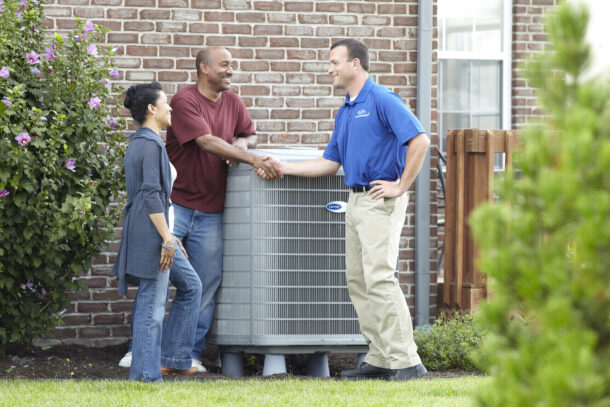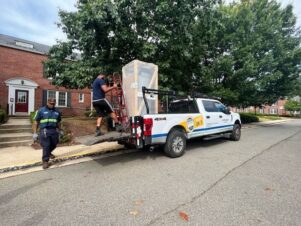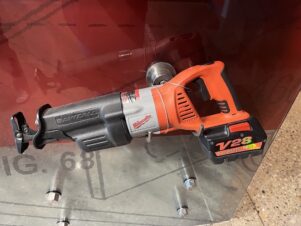In today’s world, energy efficiency is more important than ever. Not only does improving your home’s energy efficiency help reduce utility bills, but it also contributes to a more sustainable environment. Small changes and regular maintenance can significantly lower energy consumption, making your home more comfortable and cost-effective to run.
One of the best ways to achieve these energy-saving goals is by leveraging the expertise of professional handyman services. A skilled handyman can help identify areas where your home may be losing energy and implement simple, effective upgrades that make a big difference. Whether it’s sealing drafts, optimizing your HVAC system, or improving insulation, these improvements can have a substantial impact on your home’s overall efficiency.
In this article, we’ll explore some practical steps you can take to enhance your home’s energy efficiency with the help of a professional handyman. From detecting and sealing energy leaks to making smart upgrades, we’ll cover everything you need to know to make your home more energy-efficient and environmentally friendly. If you’re ready to start saving energy and lowering your utility bills, read on to discover how a handyman can help you achieve your goals.

Section 1: Identifying Energy Leaks in Your Home
Energy leaks are one of the most common reasons for high utility bills and reduced energy efficiency in homes. These leaks allow warm air to escape during the winter and cool air to escape during the summer, forcing your HVAC system to work harder to maintain a comfortable temperature. Identifying and sealing these leaks is a crucial first step in improving your home’s energy efficiency.
Subsection 1.1: Common Areas Where Energy Loss Occurs
Energy leaks can occur in various parts of your home, often in places you might not immediately think of. Some of the most common areas where energy loss occurs include:
- Windows and Doors: Gaps around windows and doors are major culprits of energy loss. Over time, weatherstripping can wear down, and caulking can crack, allowing drafts to enter your home.
- Ductwork: Leaky ductwork can cause significant energy loss as conditioned air escapes before it reaches its intended destination. Poorly sealed ducts can reduce your HVAC system’s efficiency by up to 20%.
- Attics and Basements: These areas are often under-insulated, leading to significant heat loss in the winter and heat gain in the summer. Cracks and gaps in the foundation and walls can also contribute to energy inefficiency.
- Electrical Outlets and Switches: These often-overlooked areas can be sources of drafts, especially in older homes. Adding insulation behind outlet and switch plates can help reduce energy loss.
Subsection 1.2: How a Professional Can Help Detect and Seal Energy Leaks
A professional handyman can play a vital role in identifying and addressing these energy leaks. Here’s how they can help:
- Thorough Inspection: A handyman can conduct a comprehensive inspection of your home to identify areas where energy is being lost. They can check windows, doors, ductwork, and other potential problem areas using specialized tools to detect drafts and leaks.
- Sealing Gaps and Cracks: Once energy leaks are identified, a handyman can apply caulking and weatherstripping to seal gaps around windows and doors. They can also seal leaks in ductwork with mastic or metal tape, ensuring your HVAC system operates more efficiently.
- Insulating Problem Areas: If your attic, basement, or walls are under-insulated, a handyman can add insulation where needed, helping to reduce heat loss in the winter and heat gain in the summer.
- Upgrading Outlets and Switches: A handyman can install foam gaskets behind electrical outlets and switch plates to minimize drafts and improve overall energy efficiency.
By addressing these common areas of energy loss, you can significantly reduce your home’s energy consumption and improve comfort year-round.
Section 2: Enhancing HVAC Efficiency with Professional Services
Your HVAC system plays a crucial role in maintaining a comfortable indoor environment, but it can also be one of the biggest energy consumers in your home. By ensuring your HVAC system is operating efficiently, you can significantly reduce energy costs and extend the life of your equipment. A professional handyman can help optimize your HVAC system through regular maintenance and simple adjustments that make a big difference.
Subsection 2.1: Routine HVAC Maintenance Tasks
Routine maintenance is essential for keeping your HVAC system running efficiently. Here are some key tasks that a handyman can handle to ensure your system is performing at its best:
- Changing Air Filters: One of the simplest yet most effective ways to improve HVAC efficiency is by regularly changing air filters. Dirty filters restrict airflow, forcing your system to work harder and use more energy. A handyman can replace filters as part of a regular maintenance schedule, helping to keep your system running smoothly.
- Cleaning Vents and Ducts: Dust and debris can accumulate in your home’s vents and ductwork over time, reducing airflow and efficiency. A handyman can clean these areas, ensuring that air can move freely throughout your home. Clean ducts also improve indoor air quality by reducing the circulation of dust and allergens.
- Checking for Blockages: Blockages in the airflow, such as obstructed vents or blocked return air registers, can cause your HVAC system to overwork. A handyman can inspect your home for any blockages and clear them, ensuring optimal airflow and reducing strain on your system.

Subsection 2.2: Optimizing Thermostat Settings
Thermostat settings have a significant impact on your home’s energy consumption. By making a few adjustments, you can reduce your energy usage without sacrificing comfort. A handyman can assist with the following:
- Installing Programmable Thermostats: Programmable thermostats allow you to set your HVAC system to automatically adjust the temperature based on your schedule. This ensures that your system isn’t working hard to heat or cool your home when it’s not needed, such as when you’re at work or asleep. A handyman can install and set up these thermostats for you, optimizing your energy use.
- Calibrating Existing Thermostats: If your current thermostat isn’t accurately reading the temperature, it could be causing your HVAC system to run longer than necessary. A handyman can calibrate your thermostat to ensure it’s giving accurate readings, helping your system run more efficiently.
- Zoning Systems: For larger homes, zoning systems allow different areas of the home to be heated or cooled independently. A handyman can assist with setting up or adjusting these systems, ensuring that you’re only using energy where and when it’s needed.
By focusing on these routine maintenance tasks and optimizing your thermostat settings, you can ensure that your HVAC system runs efficiently, saving you money on energy bills while keeping your home comfortable.
Section 3: Improving Insulation and Reducing Heat Loss
Proper insulation is key to maintaining energy efficiency in your home. Without adequate insulation, your home loses heat in the winter and gains heat in the summer, causing your HVAC system to work harder than necessary. By improving insulation, you can significantly reduce energy consumption and create a more comfortable living environment. A professional handyman can assess your home’s insulation and make necessary improvements to enhance its efficiency.
Subsection 3.1: The Role of Proper Insulation
Insulation acts as a barrier that keeps warm air inside during the winter and cool air inside during the summer. If your home is under-insulated, you’re likely losing a significant amount of energy, which translates to higher utility bills. Common areas that may require insulation upgrades include:
- Attics: Heat rises, making the attic one of the primary areas where energy loss occurs. A well-insulated attic can prevent heat from escaping in the winter and keep your home cooler in the summer.
- Walls: Insulating exterior walls helps maintain a consistent indoor temperature and reduces the workload on your HVAC system. This is particularly important for older homes that may have inadequate or no insulation in the walls.
- Basements and Crawl Spaces: Uninsulated basements and crawl spaces can be major sources of heat loss. Insulating these areas can help prevent cold floors and reduce overall energy consumption.
- Windows and Doors: While not technically insulation, sealing gaps around windows and doors with weatherstripping or caulk is crucial to preventing drafts and energy loss.
Subsection 3.2: Pipe Insulation and Water Heater Efficiency
In addition to insulating your home’s structure, insulating your pipes can also contribute to energy savings. Here’s how a handyman can help:
- Pipe Insulation: Insulating hot water pipes reduces heat loss, meaning your water heater doesn’t have to work as hard to deliver hot water. This is especially beneficial in unheated areas of your home, such as basements and crawl spaces. A handyman can install foam pipe insulation to minimize heat loss and improve efficiency.
- Water Heater Maintenance: Ensuring your water heater operates efficiently can lead to significant energy savings. A handyman can adjust the temperature settings, insulate the water heater, and check for leaks to ensure it’s functioning at peak efficiency. Installing a water heater blanket can also reduce energy loss, especially for older units.
By improving insulation in key areas of your home and insulating your pipes, you can significantly reduce energy consumption, lower your utility bills, and create a more comfortable living environment.
Section 4: Simple Upgrades to Boost Energy Efficiency
In addition to improving insulation and optimizing your HVAC system, there are several simple upgrades that can significantly boost your home’s energy efficiency. These upgrades are relatively easy to implement and can result in noticeable savings on your utility bills. A professional handyman can help you with these tasks, ensuring they are done correctly and efficiently.
Subsection 4.1: Energy-Efficient Lighting Solutions
Lighting accounts for a significant portion of a home’s energy use, especially if you’re still using traditional incandescent bulbs. Upgrading to energy-efficient lighting is one of the simplest ways to reduce energy consumption:
- Switching to LED Bulbs: LED bulbs use up to 75% less energy than incandescent bulbs and last much longer. A handyman can help you replace all the outdated bulbs in your home with LEDs, which not only reduces energy use but also lowers maintenance costs since these bulbs need to be replaced less frequently.
- Installing Dimmers and Motion Sensors: Installing dimmer switches and motion sensors can further enhance energy savings by allowing you to control the amount of light used and ensuring lights are only on when needed. A handyman can easily install these devices throughout your home, providing both energy savings and added convenience.
Subsection 4.2: Installing Draft Stoppers and Window Film
Drafts from windows and doors can lead to significant heat loss in the winter and heat gain in the summer, making your HVAC system work harder than necessary. Here are some simple solutions to address these issues:
- Draft Stoppers for Doors: Draft stoppers are an easy and inexpensive way to prevent air leaks under doors. A handyman can install draft stoppers on all exterior doors, helping to keep conditioned air inside your home.
- Window Insulating Film: Applying window insulating film can reduce heat loss through windows during the winter and block heat gain during the summer. This film is particularly effective for older windows that may not be as energy-efficient as modern ones. A handyman can expertly apply this film to ensure a smooth, bubble-free finish.
- Weatherstripping: Adding or replacing weatherstripping around windows and doors is another effective way to seal out drafts. A handyman can install weatherstripping to create a tight seal, reducing energy loss and improving comfort.
By implementing these simple upgrades, you can make your home more energy-efficient and reduce your overall energy costs. These small changes add up, providing you with a more comfortable living environment and long-term savings on your utility bills.
Conclusion
Improving your home’s energy efficiency is not only beneficial for reducing utility costs but also for creating a more comfortable and sustainable living environment. From sealing energy leaks and optimizing your HVAC system to enhancing insulation and making simple upgrades, there are numerous ways to boost your home’s efficiency with the help of a professional handyman.
By addressing these critical areas, you can significantly lower your energy consumption, reduce your carbon footprint, and enjoy the added benefits of increased comfort and long-term savings. A skilled handyman can ensure that these improvements are implemented correctly and efficiently, maximizing the impact on your home’s energy performance.
Whether you’re looking to make small changes or undertake more significant improvements, Elite Cleveland Handyman is here to help. Their team of experienced professionals can assist with everything from routine maintenance to major energy-saving upgrades, ensuring your home remains efficient and comfortable year-round.
To learn more about how Elite Cleveland Handyman can assist with your energy efficiency projects, visit Elite Cleveland Handyman. If you’re ready to take the next step, you can request a personalized quote today at Request a Quote. Let the experts at Elite Cleveland Handyman help you transform your home into an energy-efficient haven.




Join the conversation: